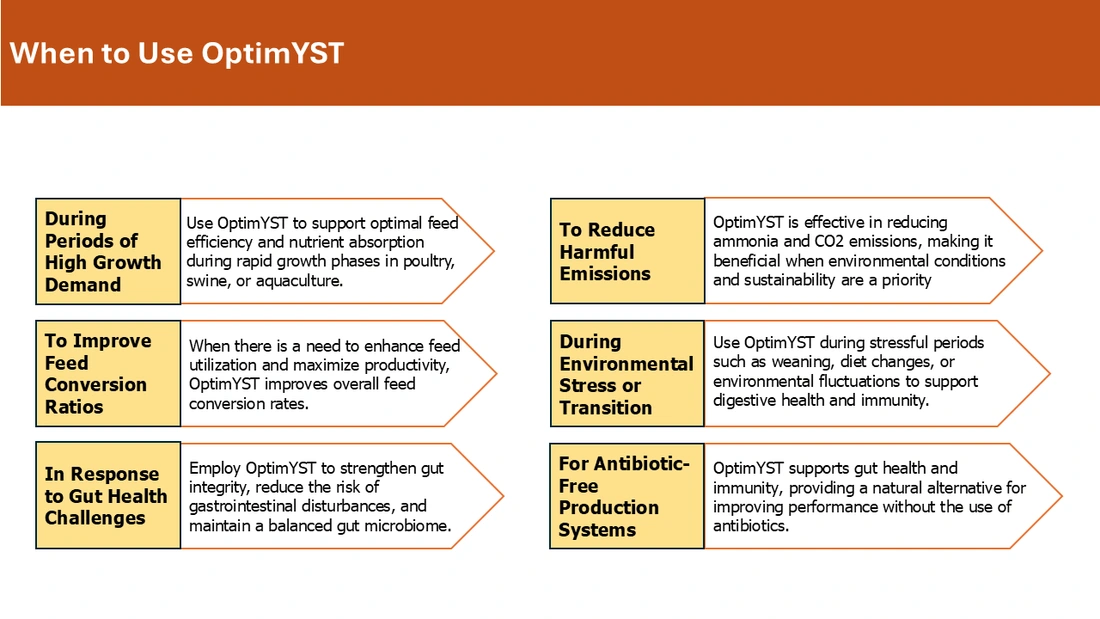
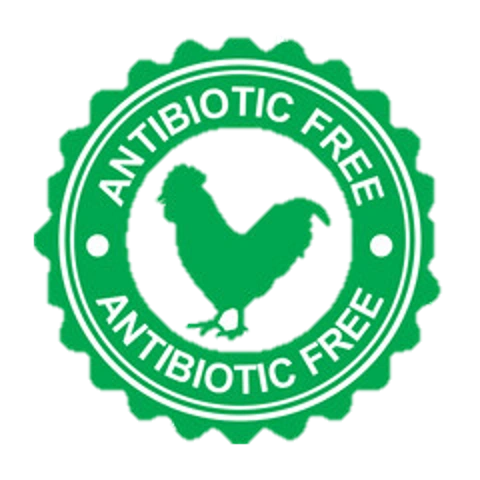
Maintaining a Gut Health in
Poultry
Challenges:
Increased
Demand for Antibiotic-Free Chicken: In recent years, there has been
significant momentum toward antibiotic-free chicken production, driven by
consumer demand for healthier and more natural products.
Adoption
of No Antibiotic Ever (NAE) Programs: Particularly in the USA, the
adoption of "No Antibiotic Ever" programs has become more prevalent,
presenting both an opportunity and a challenge for poultry producers.
Impact
on Production Performance: The
reduction in antibiotic use has led to challenges in maintaining production
performance, primarily due to gut health issues. Without antibiotics, animals
are more susceptible to infections, which can compromise growth rates and
overall efficiency.
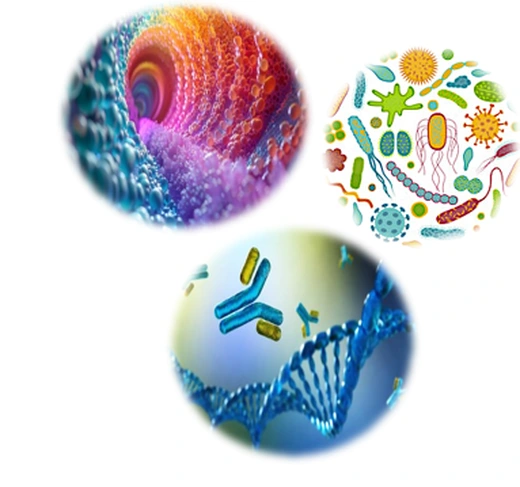
What is gut health?
Simply put, gut health means
- Good structural integrity of the intestine, both gross and microscopic
- Healthy balance of gut microflora, and
- Healthy status of the gut immune system
The efficient conversion of feed into its basic components for optimal nutrient absorption is vital for both broiler and broiler breeder production and welfare.
Gut health, an intricate and complex area combining nutrition, microbiology, immunology and physiology, has a key role to play. When gut health is compromised, digestion and nutrient absorption are affected which, in turn, can have a detrimental affect on feed conversion leading to economic loss and a greater susceptibility to disease. In addition, recent changes in legislation on the use of antimicrobials, differing feed requirements and more efficient birds highlight the need for a better understanding of gut function and gut health.
It is generally considered that the development of the adult gut microbiota begins on hatching where bacteria are picked up from the environment, the feed, and the people handling the chicks post-hatch. The crop is rapidly colonised within 24 hours. After one day post-hatch, the ileum and caeca are also both dominated by bacteria. After three days, the level of bacteria in the small and large intestine increases 10-fold. Within two weeks, the typical adult small intestinal microbiota will be well established and after 30 days, the caecal flora will have also developed. The time taken for the establishment of the stable adult microbiota can be reduced with optimal brooding conditions and good feed quality.
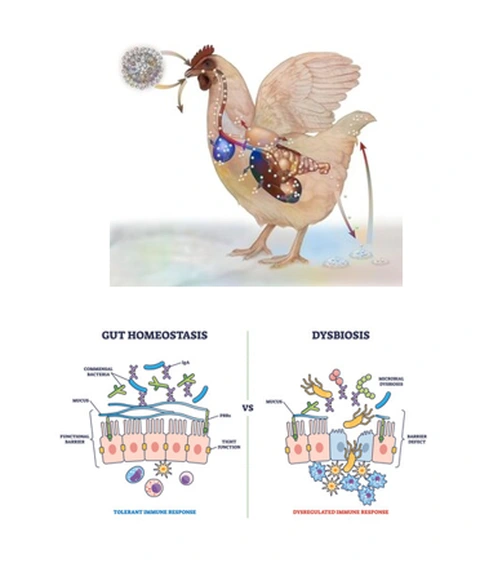 Role of the Intestinal Microbiota
Role of the Intestinal MicrobiotaWithin the GI tract, there are multiple interactions between the host (bird) cells, the intestinal environment, bacterial cells and feed components. These interactions emphasise the extremely important role of gut microbiota in the health and well-being of the host.
The bacterial community of the intestinal microbiota form a protective barrier which lines the gut, preventing the growth of pathogenic bacteria such as Salmonella, Campylobacter and Clostridium perfringens through competitive exclusion. Theories suggest that the commensal (or friendly) microbiota dominate attachment sites on the gut cells, reducing the opportunity for attachment and colonisation by pathogens. Another proposed mechanism is that the intestinal microbiota can secrete compounds - including volatile fatty acids, organic acids, and natural antimicrobial compounds (known as bacteriocins) - that either inhibit the growth of or make the environment unsuitable for less favourable bacteria.
The gut microbiota is also considered to be an important factor in the development and maturation of the immune system. Studies have shown that animals lacking a gut microbiota are more susceptible to disease and have poorly developed immune tissues.
In addition to protection against disease and stimulation of the immune system, the intestinal microbiota can influence host growth rates by producing extra nutrients through the fermentation of the indigestible plant fibres that the birds cannot digest.
Through the diet it is possible to modify the gut microbial population and have the growth of favorable bacteria in the gut. Commensal microflora (good bacteria) in the gut plays important roles in the prevention of intestinal inflammation. Through their products (SCFAs), the commensal bacteria may exert anti-inflammatory activities, thus preventing the intestinal damage.
Dysbacteriosis is an imbalance in the gut microbiota as a consequence of an intestinal disruption can result from environmental stress, viral or bacterial challenge, coccidiosis or in response to feed change. It results in poor nutrient absorption in the gut leading to poorer FCR and reduced liveweight. If dysbacteriosis is severe enough, it can contribute to wet litter.
 What are Effective ways to mitigate Gut Health challenges?
What are Effective ways to mitigate Gut Health challenges?Mitigating gut health challenges is crucial for ensuring optimal growth, feed efficiency, and overall health in livestock.
Gut health challenges in ABF poultry production can be alleviated with multifactorial approaches, including changes in nutrition and improved management practices. Innovative feed additive technologies have contributed to reducing production losses triggered by the removal of AGPs in poultry production.
Natural Ingredients and phytomolecules are one such promising technology, with proven benefits in terms of the production performance of poultry. Phytomolecules are generally recognized as safe and are commonly used in the food industry. Some of the phytomolecules combinations have multiple modes of action, supporting an efficient and sustainable reduction in antibiotics use in poultry production.
Maintain gut health is essential for achieving profitable production
Good intestinal health is the primary requirement in the poultry industry to achieve target feed efficiency and growth rate. The reduction of antibiotic use poses some challenges to poultry producers. Apart from increased capital investment for modifications in feed mills and farms, increase in feed additive cost, the main challenge due to the removal of AGPs from feed can be the reduced production performance of poultry, mainly due to increased gut health issues.
“The intestinal health of poultry has broad implications for the systemic health of birds, animal welfare, the production efficiency of flocks, food safety, and environmental impact,” state Oviedo-Rondón (2019). The main challenges for ABF chicken or turkey production fall under the same heading of gut health, in particular the prevention and control of coccidiosis and necrotic enteritis (Cervantes, 2015).
Vansh Specialities committed to gaining a better understanding of gut flora, gut function and gut immunity by undertaking internal research projects and collaborating with universities to ensure the latest technologies and knowledge are exploited to improve bird gut health in the field.
 Our Solution OptimYST
Our Solution OptimYSTOptimYST revolutionizes broiler poultry nutrition by optimizing gut health through a scientifically formulated blend. It promotes a balanced gut microbiota, enhancing nutrient absorption and maximizing feed efficiency for accelerated growth. By bolstering immune function and mitigating digestive challenges, OptimYST ensures robust health and vitality in every bird, translating to superior performance and profitability on your farm.
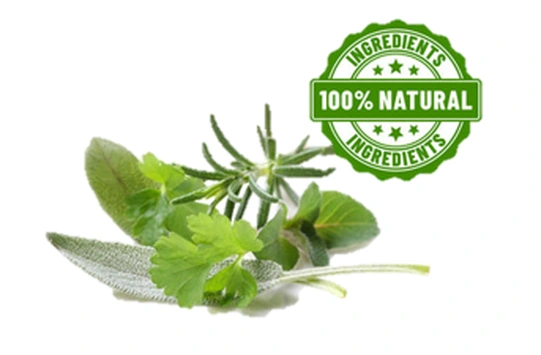 What
OptimYST Offers?
What
OptimYST Offers?The integrated approach to gut
modulation and health leverages a combination of natural agents that work
synergistically to optimize the gut environment. This strategy involves
- Blocking harmful pathogens from attaching to the gut lining, thereby reducing the risk of infections.
- Beneficial microbes are supported to outcompete harmful bacteria, promoting a balanced gut microbiome. Additionally, certain agents directly break down bacterial cell walls, adding an extra layer of protection against infections.
- Anti-inflammatory and antioxidant properties help to reduce gut irritation and oxidative stress, creating a more stable and healthier gut environment.
- Furthermore, this approach reduces harmful compounds like ammonia in the gut, which not only prevents irritation but also enhances nutrient absorption.
- Collectively, these effects contribute to improved gut health, leading to better digestion, enhanced immunity, and overall increased efficiency in animal production.
Key Features of OptimYST
Advance Health Gut Formula
Enhances digestive enzyme activity and nutrient absorption for optimal animal growth and performance
Multi Species Application
Effective across broilers, layers, swine, and aquaculture, providing versatile feed solutions.
Natural Ingredients
Powered by a blend of phytogenic compounds, yeast derivatives, and probiotics, ensuring safe and sustainable feed enhancement.
Improved Feed Efficiency
Maximizes feed conversion rates, leading to better productivity and cost-efficiency.
Boosted Immune Response
Strengthens natural defensce against gut pathogens, reducing the need for antibiotics and improving animal health.
Supports Growth Performance
Promotes faster weight gain and enhances overall performance, leading to higher production outputs.
Reduced Digestive Disorders
Minimizes the occurrence of gastrointestinal issues, leading to healthier animals and lower mortality rates.
Easy to Incorporate
Flexible in feed formulation and compatible with existing feed programs, making it simple to integrate into various production systems.
